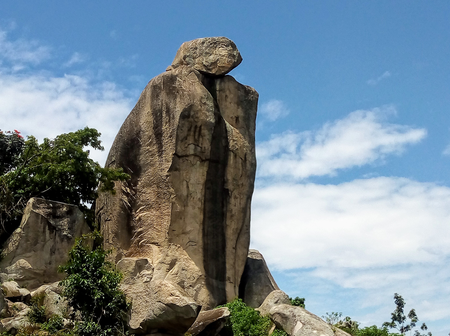Of Cultural Ties To The Crying Stone

Image sourced from Opera News

Image sourced from Opera News
Crying has always been thought to be a phenomenon exclusive to human beings. Yet, if you delve into science, you’ll find that crocodiles have also been known to shed a tear or two as they enjoy their midnight snacks, while elephants are believed to mourn their dead. This is not the case for plants and other inanimate objects – except one special stone that can only be found in Kenya, specifically in Kakamega County.
It’s called the crying stone and legend has it that it was once a happily married man. He had no troubles, and, therefore, no reason to cry. One day, the man woke up to discover that his beloved wife had left him for another man. His heart was broken, and he wept inconsolably. Ever since that tragic day, the man has been waiting for his wife to return, but as she never has. So, he stands alone on the side of the road, weeping, with no one to comfort him. Eventually, he turned into a rock, but his tears continued to flow, earning him the name, The Crying Stone of Ilesi.
To most locals however, the stone is known as Ikhongo Murwi.
Those who flock to Kakamega Town, desperate to snap a picture of this natural wonder, simply regard Ikhongo Murwi as a tourist attraction. And to naturally sceptical scientists, The Crying Stone is just a large boulder, balanced on a column of rock, with water flowing from a groove at its centre. However, to the Luhya community who have lived around the stone for hundreds of years, Ikhongo Murwi has a much deeper significance. To them, it is a sacred spiritual and cultural site.
Not only is Ikhongo Murwi a signifier of the rainy season to come, but it is also a source of magical protection. Before we had our present county demarcations, the stone was regarded a boundary between the Luhya and the Nandi territories. Both communities believed that Ikhongo Murwi had magical powers and was protecting the Luhyas. Upset that they kept losing wars, the Nandis tried to topple the stone. They sent their best warriors to carry out the task, but their efforts were futile and 100 of them died.
The caves beneath Ikhongo Murwi are also used for healing rituals by the Isukha sub-tribe. If one has committed a crime or a taboo act, they must be cleansed in the caves before being allowed to re-join society. The ritual involves animal sacrifices, food preparation and performances of the traditional Isukuti dance in celebration of the successful ceremony.
In recent years, the tears of The Crying Stone of Ilesi have dried up. Perhaps this is because the heartbroken man has finally moved past his sadness towards his wife’s departure. However, some researchers suspect that this is a result of the presence of eucalyptus trees nearby which are sucking up most of the groundwater. The Isukha people themselves are also in danger of displacement, as the government has plans to build a resort in the area around the stone.
Next time you’re driving along the Kisumu-Kakamega Highway look out for The Crying Stone. Perhaps you can even drop by to offer him some words of encouragement.
#KePlaces




1 Comment
Beautiful story and well written 😃 😀 👏